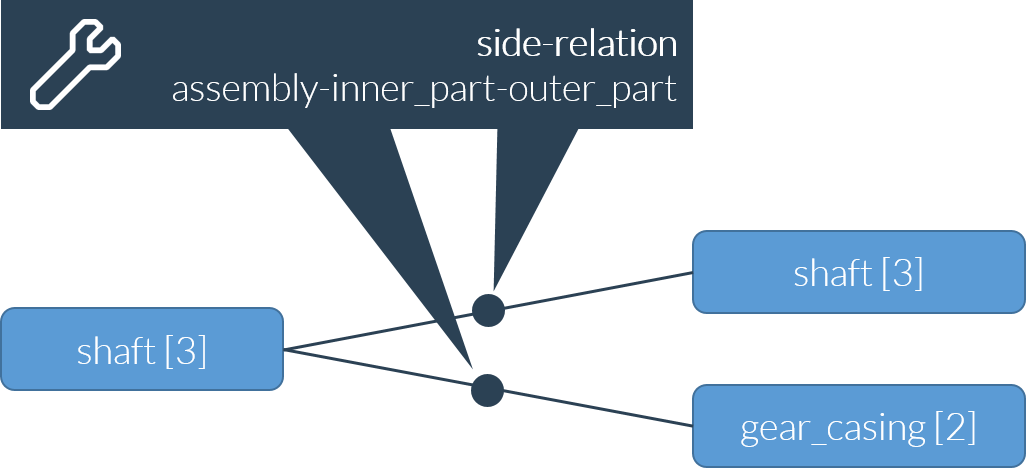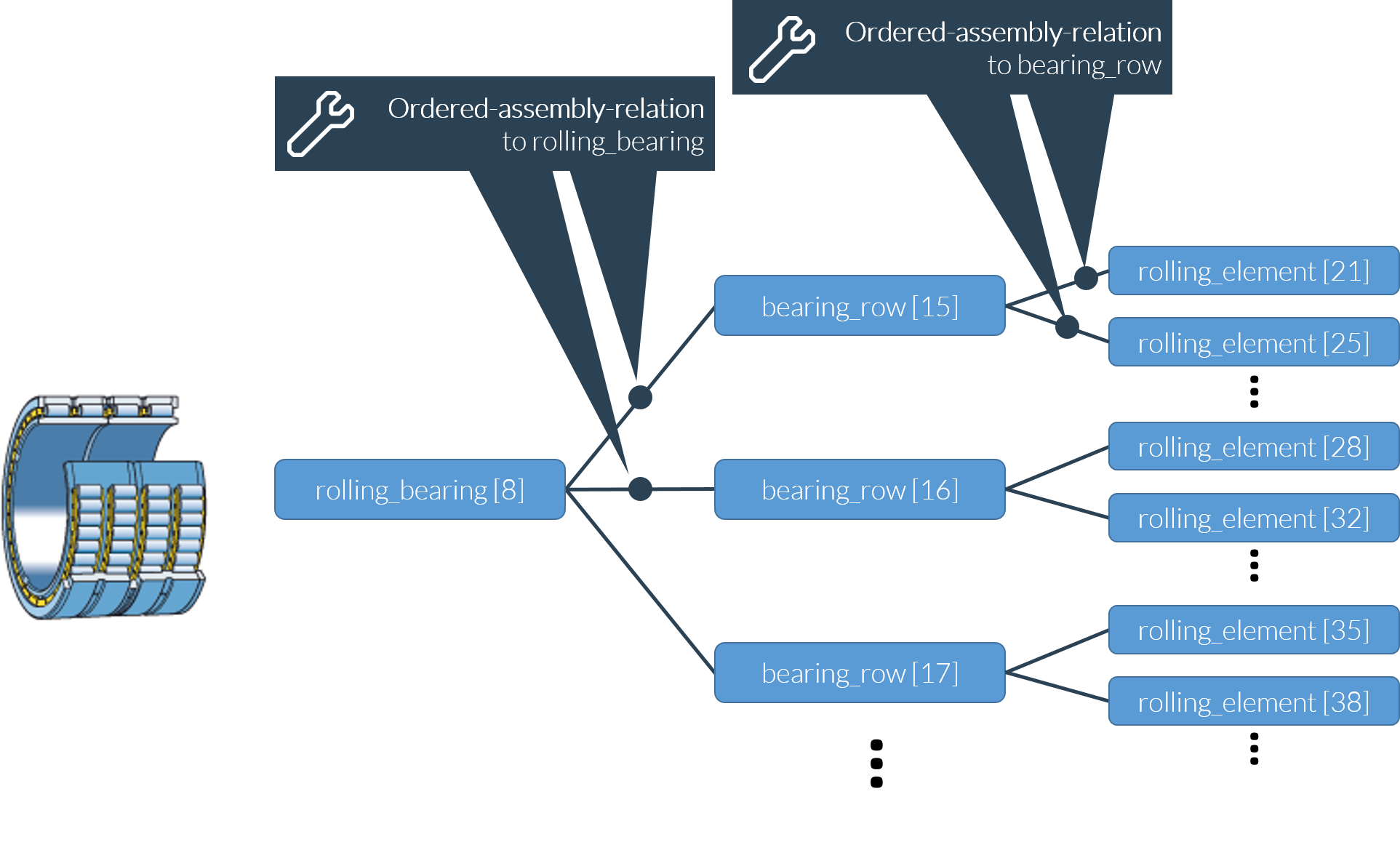Bearings
Bearings can be represented with various levels of detail. Abstract concept bearings are the most general form of a bearing. They include information about the position and rigidity of the bearing location. The conventions for construction and relations also apply to rolling bearings and plain bearings.
Connecting the bearing in the model
A bearing is connected with two components via a side relation. The role of the "inner_part“ refers to the component that is mounted to the inner diameter of the bearing. Similarly, the role of the "outer_part" refers to the component that is mounted to the outer diameter of the bearing.
If no specific inner and outer side can be identified (abstract concept bearings), the "inner_part"/"outer_part" roles can be defined arbitrarily; e.g., inner_part = left for axial connections.
Required components | XML syntax |
|---|---|
Bearings | <component id="12" type="concept_bearing"> ... </component> |
Two of the following component types are required, depending on the components that are connected by the coupling:
Optional components | XML syntax |
|---|---|
Shaft | <component id="15" type="shaft"> ... </component> |
Casing | <component id="2" type="gear_casing"> ... </component> |
Side plate | <component id="10" type="side_plate"> ... </component> |
Exactly one of the following relations is required, depending on the components that are connected by the bearing:
Required relations | XML syntax |
|---|---|
Side relation for shaft-in-shaft bearing arrangements | <relation id="16" type="side"> <ref id="12" role="assembly" hint="concept_bearing"/> <ref id="8" role="inner_part" hint="shaft"/> <ref id="20" role="outer_part" hint="shaft"/> </relation> |
Side relation for bearings within the casing | <relation id="18" type="side"> <ref id="12" role="assembly" hint="concept_bearing"/> <ref id="20" role="inner_part" hint="shaft"/> <ref id="2" role="outer_part" hint="gear_casing"/> </relation> |
Side relation for bearings on the casing journals | <relation id="18" type="side"> <ref id="12" role="assembly" hint="concept_bearing"/> <ref id="2" role="inner_part" hint="gear_casing"/> <ref id="20" role="outer_part" hint="shaft"/> </relation> |
Side relation for bearings in the side plate | <relation id="17" type="side"> <ref id="12" role="assembly" hint="concept_bearing"/> <ref id="8" role="inner_part" hint="shaft"/> <ref id="10" role="outer_part" hint="side_plate"/> <relation> |

Rolling bearings
A distinction is made between two types of rolling bearings:
For rolling_bearing_with_catalog_geometry components, the catalog information is either explicitly or implicitly (reference to catalog) specified.
For rolling_bearing_with_detailed_geometry components, the internal geometry of the bearing is either explicitly or implicitly (special file) specified.
As many modeling details apply to both, they are grouped together under the abstract term rolling_bearing. A rolling bearing consists of a number of bearing rows, which in turn consist of a number of rolling elements.
Bearing series and rolling elements
The bearing-to-bearing row and bearing row-to-rolling element associations are represented by ordered assembly relations.

Required components | XML syntax |
|---|---|
bearing_row 1 | <component id="15" type="bearing_row"> ... </component> |
... | ... |
bearing_row n | <component id="18" type="bearing_row"> ... </component> |
rolling_element 1 | <component id="21" type="rolling_element"> ... </component> |
... | ... |
rolling_element_m | <component id="40" type="rolling_element"> ... </component> |
Required components | XML syntax |
|---|---|
Side relation rolling_bearing – shaft – gear_casing | <relation id="1" type="side"> <ref id="8" role="assembly" hint="rolling_bearing"/> <ref id="3" role="inner_part" hint="shaft"/> <ref id="2" role="outer_part" hint="gear_casing"/> </relation> |
Ordered assembly relation rolling_bearing – bearing_row order 1 | <relation id="4" type="ordered_assembly" order="1"> <ref id="8" role="assembly" hint="rolling_bearing"/> <ref id="15" role="part" hint="bearing_row"/> </relation> |
Ordered assembly relation rolling_bearing – bearing_row order 2 | <relation id="5" type="ordered_assembly" order="2"> <ref id="8" role="assembly" hint="rolling_bearing"/> <ref id="16" role="part" hint="bearing_row"/> </relation> |
... | ... |
Ordered assembly relation bearing_row – rolling_element order 1 | <relation id="6" type="ordered_assembly" order="1"> <ref id="15" role="assembly" hint="bearing_row"/> <ref id="21" role="part" hint="rolling_element"/> </relation> |
Ordered assembly relation bearing_row – rolling_element order 2 | <relation id="7" type="ordered_assembly" order="2"> <ref id="15" role="assembly" hint="bearing_row"/> <ref id="22" role="part" hint="rolling_element"/> </relation> |
... | ... |
The attributes all_rows_are_identical for the bearing component and all_rolling_elements_are_identical for the bearing_row component included in REXS 1.0 have been removed. All bearing rows must always be explicitly modeled.
Clarification for specific bearing types:
Four-point contact ball bearings have one row of balls
Cross-roller bearings have two rows of rollers with different pressure angles, etc.
Rolling element contacts | rolling_element_contact
The rolling element contact component (rolling_element_contact) is used to represent the various contacts of a rolling element with the raceway and the rib. It is assigned to the rolling element via an assembly relation. Multiple contacts can be assigned to a rolling element. The contact partner of the rolling element is identified by the rolling_element_contact_type attribute of the rolling_element_contact.
Required components | XML syntax |
|---|---|
rolling_element | <component id="407" type="rolling_element"> ... </component> |
rolling_element_contact | <component id="708" type="rolling_element_contact"> ... </component> |
Required relations | XML syntax |
|---|---|
assembly | <relation id="350" type="assembly"> <ref id="407" role="assembly" hint="rolling_element"/> <ref id="708" role="part" hint="rolling_element_contact"/> </relation> |